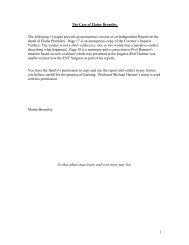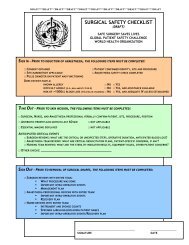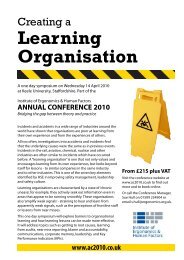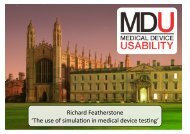The Essentials of Patient Safety - Clinical Human Factors Group
The Essentials of Patient Safety - Clinical Human Factors Group
The Essentials of Patient Safety - Clinical Human Factors Group
Create successful ePaper yourself
Turn your PDF publications into a flip-book with our unique Google optimized e-Paper software.
<strong>The</strong> <strong>Essentials</strong> <strong>of</strong> <strong>Patient</strong> <strong>Safety</strong><br />
Table 4.1 Principles for reducing medication error<br />
Reducing errors due to<br />
information complexity<br />
Limit hospital formularies to essential drugs and doses<br />
Pharmacists on ward rounds to monitor and advise<br />
Briefing at handover and shift change on<br />
circumstances that increase risk <strong>of</strong> error, such as an<br />
unfamiliar disease, new staff or unusual drug regimens<br />
Reducing errors due to<br />
complex or dangerous<br />
medication<br />
Provide an information system that allows access to<br />
patient information for all staff and allows electronic<br />
prescribing<br />
Remove high risk medications, such as concentrated<br />
electrolyte solutions, from patient care areas<br />
Label high risk drugs clearly to indicate their danger<br />
Remove or clearly differentiate look alike or sound<br />
alike drugs<br />
Reducing errors due to<br />
multiple competing tasks<br />
Wherever possible reallocate tasks such as calculating,<br />
drawing up and mixing doses to pharmacy or the<br />
manufacturer<br />
Establish standard drug administration times and avoid<br />
interruptions at those times<br />
Assign one person to necessary double checks who<br />
does not have other duties at that time; use double<br />
checks sparingly and make them properly independent<br />
Standardise equipment and supplies, such as<br />
intravenous pumps, across all units<br />
Involve patients in active checks such as identifying<br />
themselves, checking drugs and allergies<br />
Adapted from Berwick 1998<br />
Reducing medication errors and adverse drug events<br />
St Joseph Medical Centre is a 165 bed hospital in the heart <strong>of</strong> Illinois, providing a<br />
variety <strong>of</strong> services including open heart surgery and trauma care. <strong>The</strong> hospital has<br />
established a number <strong>of</strong> safety projects backed by a strong commitment to cultural<br />
change and backing from senior executives (8).<br />
In June 2001 a survey <strong>of</strong> records suggested an ADE (adverse drug event) rate<br />
<strong>of</strong> 5.8 per 1000. Flowcharting <strong>of</strong> the medication process showed that it was<br />
complicated and labour intensive. Multiple members <strong>of</strong> staff were involved from the<br />
31








